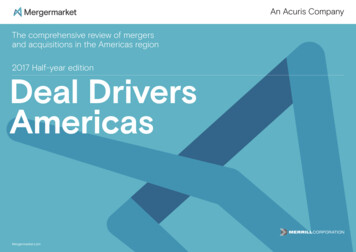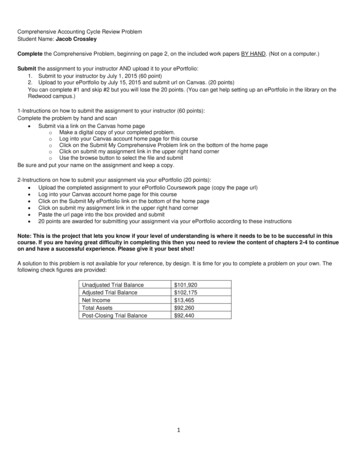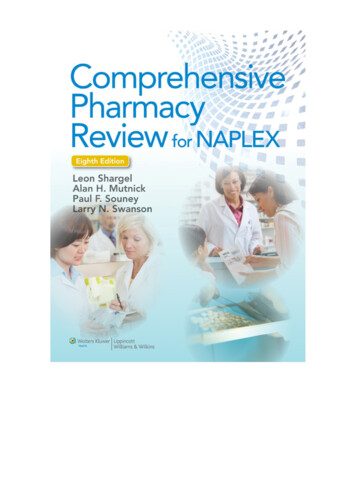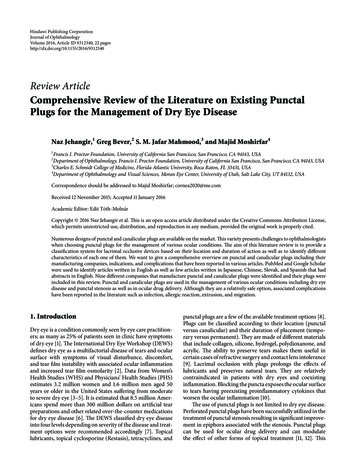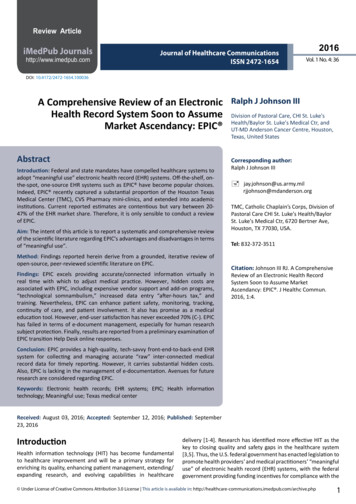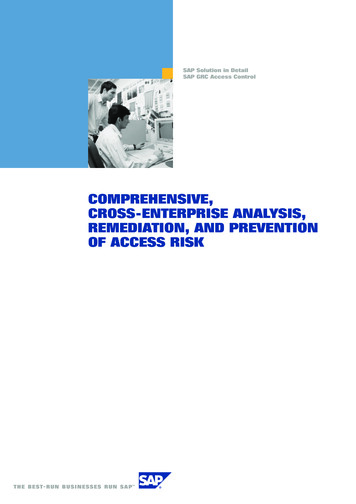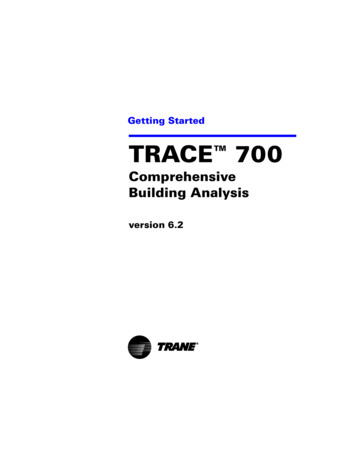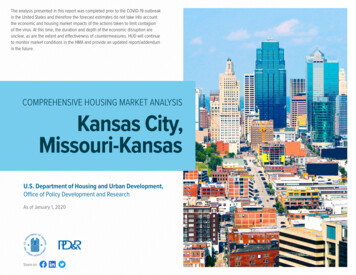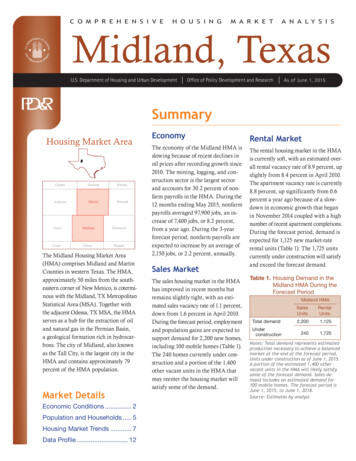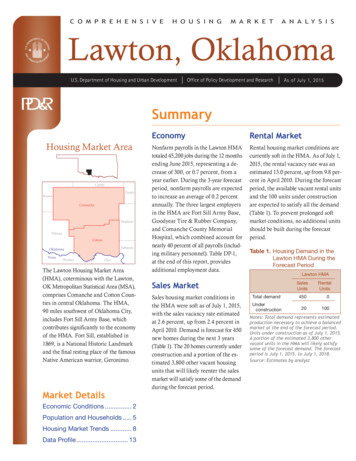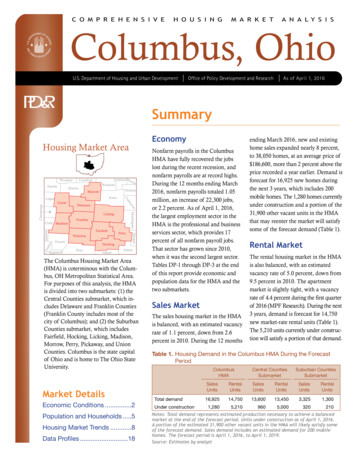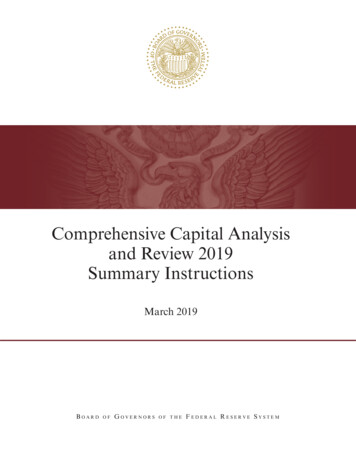
Transcription
Comprehensive Capital Analysisand Review 2019Summary InstructionsMarch 2019BOARDOFGOVERNORSOF THEFEDERAL RESERVE SYSTEM
Comprehensive Capital Analysisand Review 2019Summary InstructionsMarch 2019BOARDOFGOVERNORSOF THEFEDERAL RESERVE SYSTEM
This and other Federal Reserve Board reports and publications are available online To order copies of Federal Reserve Board publications offered in print,see the Board’s Publication Order Form (www.federalreserve.gov/files/orderform.pdf)or contact:Printing and FulfillmentMail Stop K1-120Board of Governors of the Federal Reserve SystemWashington, DC 20551(ph) 202-452-3245(fax) 202-728-5886(email) Publications-BOG@frb.gov
iiiContentsIntroduction . 1About this Publication . 1Differences between the CCAR 2019 Instructions and the Previous Year’s Instructions . 2Overview of CCAR Process . 3Communications Related to CCAR and DFAST . 4Mandatory Elements of a Capital Plan . 5Assessment of the Expected Uses and Sources of Capital . 5Description of All Capital Actions Assumed over the Planning Horizon . 8Description of a Firm’s Process for Assessing Capital Adequacy . 10Expected Changes to Business Plans Affecting Capital Adequacy or Funding . 11Organizing Capital Plan Submissions . 11Data Supporting a Capital Plan Submission . 11Federal Reserve’s Assessment of a Firm’s Capital Plan. 13Qualitative Assessments . 13Quantitative Assessments . 14Federal Reserve’s Responses to Planned Capital Actions . 16Disclosure of Supervisory Assessments . 17Resubmissions . 17Execution of Capital Plan and Requests for Additional Distributions . 17Appendix A: Templates for Comprehensive Capital Analysis andReview Results 2019 . 19Appendix B: Templates for Dodd-Frank Act Stress Testing Results2019 . 23Appendix C: Organizing Capital Plan Submissions. 27Capital Plan Narrative . 28Capital Plan and FR Y-14A Supporting Documentation . 29
1IntroductionThe Federal Reserve’s annual Comprehensive CapitalAnalysis and Review (CCAR) is an intensive assessment of the capital adequacy of the largest U.S.bank holding companies (BHCs) and U.S. intermediate holding companies of foreign banking organizations (IHCs) (collectively, firms) and of the practicesthat these firms use to assess their capital needs.1CCAR includes qualitative and quantitative assessments of firms’ capital plans. The quantitativeassessment is based on the supervisory andcompany-run stress tests that are conducted underthe Board’s rules implementing sections165(i)(1) and (2) of the Dodd-Frank Wall StreetReform and Consumer Protection Act (DFAST), asamended by the Economic Growth, RegulatoryRelief, and Consumer Protection Act (EGRRCPA).2The Federal Reserve expects the firms to have sufficient capital to withstand a severely adverse operating environment and continue to be able to lend tohouseholds and businesses, maintain operations andready access to funding, and meet obligations tocreditors and counterparties.These instructions include information about theFederal Reserve’s qualitative and quantitative assessments of capital plans submitted in connection withthis year’s CCAR exercise (CCAR 2019) by (1) firmssubject to the Large Institution Supervision Coordination Committee framework (LISCC firms) and12See 12 CFR 225.8 (capital plan rule), 12 CFR252.153(e)(2)(ii) (stating that an IHC must comply with12 CFR 225.8 in the same manner as a BHC).Pub. L. No. 111-203, 124 Stat. 1376 (2010); 12 CFR part 252,subpart E; Pub. L. No. 115-174, 132 Stat. 1296 (2018). Asdescribed below, the CCAR post-stress capital analysis uses thesame data, models, and assumptions as supervisory stress testing conducted in accordance with the Dodd-Frank Act requirements, except that the CCAR analysis involves the firm’splanned capital actions in the BHC baseline scenario ratherthan the capital actions assumptions that are required in thestress testing rules.(2) large and complex firms.3 As described more onpage 3 below, large and noncomplex firms are nolonger subject to the qualitative assessment, and forCCAR 2019, certain of those firms are not subject tothe quantitative assessment.About this PublicationThese instructions provide information regardingrequirements and expectations for CCAR 2019, thestress testing and capital planning cycle that beganon January 1, 2019. Similar to the CCAR instructions in previous years, the instructions for CCAR2019 provide information regarding: logistics for a firm’s capital plan submissions; expectations regarding the mandatory elements ofa capital plan; the qualitative assessment of a firm’s capital plan; the quantitative assessment of a firm’s post-stresscapital adequacy; the Federal Reserve’s response to a firm’s capitalplan and planned capital actions; the limited adjustments that a firm may make to itsplanned capital actions; and public disclosures by the Federal Reserve at theend of the CCAR exercise.3Under the Board’s capital plan rule (12 CFR 225.8), large andcomplex firms are BHCs and IHCs that, as of December 31, 2018,(1) have 250 billion or more in total consolidated assets,(2) have average total nonbank assets of 75 billion or more, or(3) are U.S. global systemically important bank holding companies. LISCC and large and complex firms should consult theguidance in SR letter 15-18, “Federal Reserve SupervisoryAssessment of Capital Planning and Positions for LISCCFirms and Large and Complex Firms,” December 18, rs/sr1518.htm.
2CCAR 2019 InstructionsDifferences between the CCAR 2019Instructions and the Previous Year’sInstructionsThe CCAR 2019 instructions have been updatedfrom the CCAR 2018 instructions to reflect changesto certain regulatory and reporting requirements. Removal of CCAR’s qualitative objection: Concurrent with the publication of these instructions, theBoard adopted a final rule to eliminate the Board’sauthority to object to capital plans on qualitativegrounds for firms other than those recently subjectto CCAR that continue to exhibit material deficiencies in capital planning.4 By January 1, 2021,the Board’s authority to object to capital plans onqualitative grounds will be eliminated entirely,other than for firms receiving a qualitative objection in 2020. Large and noncomplex firms exempted fromCCAR’s quantitative assessment in 2019: Certainfirms with between 100 and 250 billion in assetswill not be subject to the company-run and supervisory stress testing requirements for 2019. Additionally, while these firms remain subject to capitalplanning requirements, they are not required tosubmit their capital plans to the Federal Reserve in2019. These firms will be subject to supervisorystress testing and capital plan submission requirements in 2020.5 Certain IHCs become subject to the global marketshock and counterparty default scenario: In December 2017, the Board modified the scope of theglobal market shock component of the supervisorystress test to apply to a firm that has aggregatetrading assets and liabilities of 50 billion or more,or equal to or greater than 10 percent of total consolidated assets.6 As a result of this modification,IHCs that exceeded this threshold as of December 31, 2018, became subject to the global marketshock for CCAR 2019. IHCs are also now subjectto the counterparty default scenario. (See “Coun456In CCAR 2019, Barclays US LLC, Credit Suisse Holdings(USA), DB USA Corporation, TD Group US Holdings LLC,and UBS Americas Holdings LLC are subject to the qualitativeobjection.See Board of Governors of the Federal Reserve System, “Federal Reserve Board releases scenarios for 2019 ComprehensiveCapital Analysis and Review (CCAR) and Dodd-Frank Actstress test exercises,” press release, February 5, 2019, eases/bcreg20190205b.htm.See 82 FR 59608 (December 15, 2017).terparty Default Scenario Component” for moreinformation.) Reduced supporting documentation: In an effort toreduce burden associated with the submission ofsupporting documentation, firms will only berequired to submit documentation related to thoseelements in scope for this year’s exercise, asreflected in a scoping letter sent to each firm inDecember 2018. (See “Organizing Capital PlanSubmissions.”)CCAR and Changes in AccountingStandardsThe Financial Accounting Standards Board (FASB)periodically makes revisions to U.S. GenerallyAccepted Accounting Principles (U.S. GAAP).These changes affect a firm’s financial reportingupon adoption by the firm. The FASB made majorrevisions to accounting standards associated withrecognition and measurement of financial instruments, revenue recognition, leases, credit losses, andderivatives and hedging. The effective dates for thesestandards range from fiscal years beginning afterDecember 15, 2017, to fiscal years beginning afterDecember 15, 2020.7As was the case last year, for CCAR 2019 a firmshould not reflect the adoption of new accountingstandards in its projections unless the firm hasalready adopted the accounting standard for financial reporting purposes. If a firm was required toadopt or had voluntarily adopted a standard or aparticular provision of a standard as of December 31, 2018, that adoption should be reflected in theFR Y-14A report with December 31, 2018, as-ofdates, and in the subsequent projected quarters.With regard to Accounting Standards UpdateNo. 2016-13, Financial Instruments – Credit Losses(Topic 326): Measurement of Credit Losses onFinancial Instruments (CECL), firms should excludethe potential effect of CECL from company-runstress testing projections for CCAR 2019, even if a7The leases standard (Topic 842) was effective for annual andinterim periods beginning after December 15, 2018. The creditlosses standard (Topic 326) is effective for fiscal years beginningafter December 15, 2019, for Securities and Exchange Commission (SEC) filers and after December 15, 2020, for non-SEC filers. The derivatives and hedging standard (Topic 815) was effective for fiscal years beginning after December 15, 2018, for public business entities (PBE) and after December 15, 2019, fornon-PBE.
March 2019firm chooses to early adopt CECL for financialreporting purposes in 2019.8Overview of CCAR ProcessThe Board’s capital plan rule requires top-tier BHCsand IHCs subject to the capital plan rule to submit acapital plan to the Federal Reserve annually.9 Underthe capital plan rule, a firm’s capital plan mustinclude a detailed description of the firm’s internalprocesses for assessing capital adequacy; the boardof directors’ approved policies governing capitalactions; and the firm’s planned capital actions over anine-quarter planning horizon. Further, a firm mustreport to the Federal Reserve the results of stresstests conducted by the firm under supervisory scenarios provided by the Federal Reserve and under abaseline scenario and a stress scenario designed bythe firm (BHC baseline and BHC stress scenarios).These stress tests assess the sources and uses of capital under baseline and stressed economic and financial market conditions.Before a firm submits its capital plan to the FederalReserve, the capital plan must be approved by thefirm’s board of directors, or a committee thereof.For CCAR 2019, capital plans should be submittedto the Federal Reserve no later than April 5, 2019.10The Board conducts qualitative and quantitativeassessments of firms’ capital plans. For purposes ofthe qualitative assessment, the Federal Reserveassesses the strength of the firm’s capital planningpractices, including the firm’s ability to identify,measure, and determine the appropriate amount of8910See Board of Governors of the Federal Reserve System, “Agencies allow three-year regulatory capital phase-in for new Current Expected Credit Losses (CECL) accounting standard,”press release, December 21, 2018, eases/bcreg20181221a.htm.See the capital plan rule (12 CFR 225.8). Asset size is measuredover the previous four calendar quarters as reported on theFR Y-9C regulatory report. If a firm has not filed the FR Y-9Cfor each of the four most recent quarters, average total consolidated assets means the average of the firm’s total consolidatedassets, as reported on the firm’s FR Y-9C, for the most recentquarter or consecutive quarters. For the purposes of capitalplanning, IHCs must comply with section 12 CFR 225.8 andany successor regulation in the same manner as a BHC. See12 CFR 252.153(e)(2)(ii).A firm that meets the threshold must submit a capital plan,even if it does not intend to undertake any capital distributionsover the planning horizon.3capital for its risks, and controls and governance supporting capital planning.11 The qualitative assessment is informed by a review of the materials eachfirm provides in support of its annual capital plansubmission. In addition, the Board’s qualitativeassessment incorporates supervisory assessments ofthe firm’s capital planning process that are undertaken throughout the year.The Federal Reserve’s quantitative assessment of afirm’s capital plan is based on the supervisory andcompany-run stress tests that are conducted, in part,under the DFAST rules. The quantitative assessmentof a firm’s capital plan in CCAR includes a supervisory assessment of the firm’s ability to maintaincapital levels above each minimum regulatory capitalratio, after making the capital actions included in itscapital plan, under baseline and stressful conditionsthroughout the nine-quarter planning horizon. Seetable 1 for a list of the ratios that are applicable tofirms participating in CCAR 2019 over the planninghorizon.The quantitative and qualitative assessments serve asthe basis for the Federal Reserve’s decision to object,where applicable, or not object to a firm’s capitalplan as a part of CCAR. The decisions for all firmsparticipating in CCAR 2019, including the reasonsfor any objections to a firm’s capital plan, will bepublished on or before June 30, 2019. In addition,the Board will separately publish the results ofDFAST under the supervisory severely adverse andadverse scenarios. DFAST uses the same supervisory11See 12 CFR 225.8(f).Table 1. Required minimum capital ratios for CCAR 2019PercentRegulatory ratioCommon equity tier 1 capital ratioTier 1 risk-based capital ratioTotal risk-based capital ratioTier 1 leverage ratioSupplementary leverage ratio1Minimum ratio4.56.08.04.03.0Note: All regulatory capital ratios are calculated using the definitions of capital,standardized risk-weighted assets, average assets (for the tier 1 leverage ratio),and total leverage exposure that are in effect during a particular quarter of theplanning horizon. The advanced approaches are not used for purposes of theseprojections.1Supplementary leverage ratio applies only to advanced approaches firms.
4CCAR 2019 Instructionsstress test as in the CCAR quantitative assessmentbut with different capital action assumptions.Communications Related to CCARand DFASTThe Federal Reserve uses a secure CCAR Communications mailbox to communicate with firms on topicsrelated to CCAR and DFAST, send notificationsabout industry meetings and conference calls, andrespond to firms’ questions. Firms use the CCARCommunications mailbox to send questions to theFederal Reserve about CCAR, DFAST, the capitalplan rule, and related requirements.When a firm sends a question to the CCAR Communications mailbox, the firm receives a notificationwith a timeframe in which a response can beexpected. The Federal Reserve provides a directresponse to the firm as soon as the response is available. In addition, to help ensure that all firms receivethe same information, the Federal Reserve publishessuch questions and answers on a regular basis (1) ona secure collaboration website accessible by firmsparticipating in CCAR and (2) on the FederalReserve’s public website.1212See apital-analysis-and-review-qas.htm.
5Mandatory Elements of a Capital PlanAs noted above, a firm must submit its capital planand supporting information, including certainFR Y-14 schedules, to the Federal Reserve byApril 5, 2019, using a secure collaboration site.The capital plan rule specifies the four mandatoryelements of a capital plan:131. An assessment of the expected uses and sourcesof capital over the planning horizon that reflectsthe firm’s size, complexity, risk profile, and scopeof operations, assuming both expected andstressful conditions, including the following:a. Estimates of projected revenues, losses,reserves, and pro forma capital levels—including any minimum regulatory capitalratios (e.g., tier 1 leverage, tier 1 risk-based,common equity tier 1 risk-based, and totalrisk-based capital ratios, and supplementaryleverage ratio, as applicable) and any additional capital measures deemed relevant bythe firm—over the planning horizon underbaseline conditions and under a range ofstressed scenarios. These must include anyscenarios provided by the Federal Reserveand at least one stress scenario developed bythe firm that is appropriate to its businessmodel and activities.b. A discussion of how the firm will maintainall minimum regulatory capital ratios underexpected conditions and the required stressedscenarios.c. A discussion of the results of the stress testsrequired by law or regulation and an explanation of how the capital plan takes theseresults into account.d. A description of all planned capital actionsby the firm over the planning horizon.2. A detailed description of the firm’s process forassessing capital adequacy.3. The firm’s capital policy.4. A discussion of any expected changes to thefirm’s business plan that are likely to have amaterial impact on the firm’s capital adequacy orliquidity.In addition to these mandatory elements, the Boardalso requires firms to submit supporting informationnecessary to facilitate review of a firm’s capital planunder the capital plan rule and in accordance withthe FR Y-14 Instructions, including appendix A tothe FR Y-14A.14The remainder of this s
Mar 06, 2019 · No. 2016-13, Financial Instruments – Credit Losses (Topic 326): Measurement of Credit Losses on Financial Instruments (CECL), firms should exclude the potential effect of CECL from company-run stress testing projections for CCAR 2019, even if a 4 In CCAR 2019, Barclays US LLC, Credit Suisse Holdings (USA), DB USA Corporation, TD Group US .File Size: 507KB

